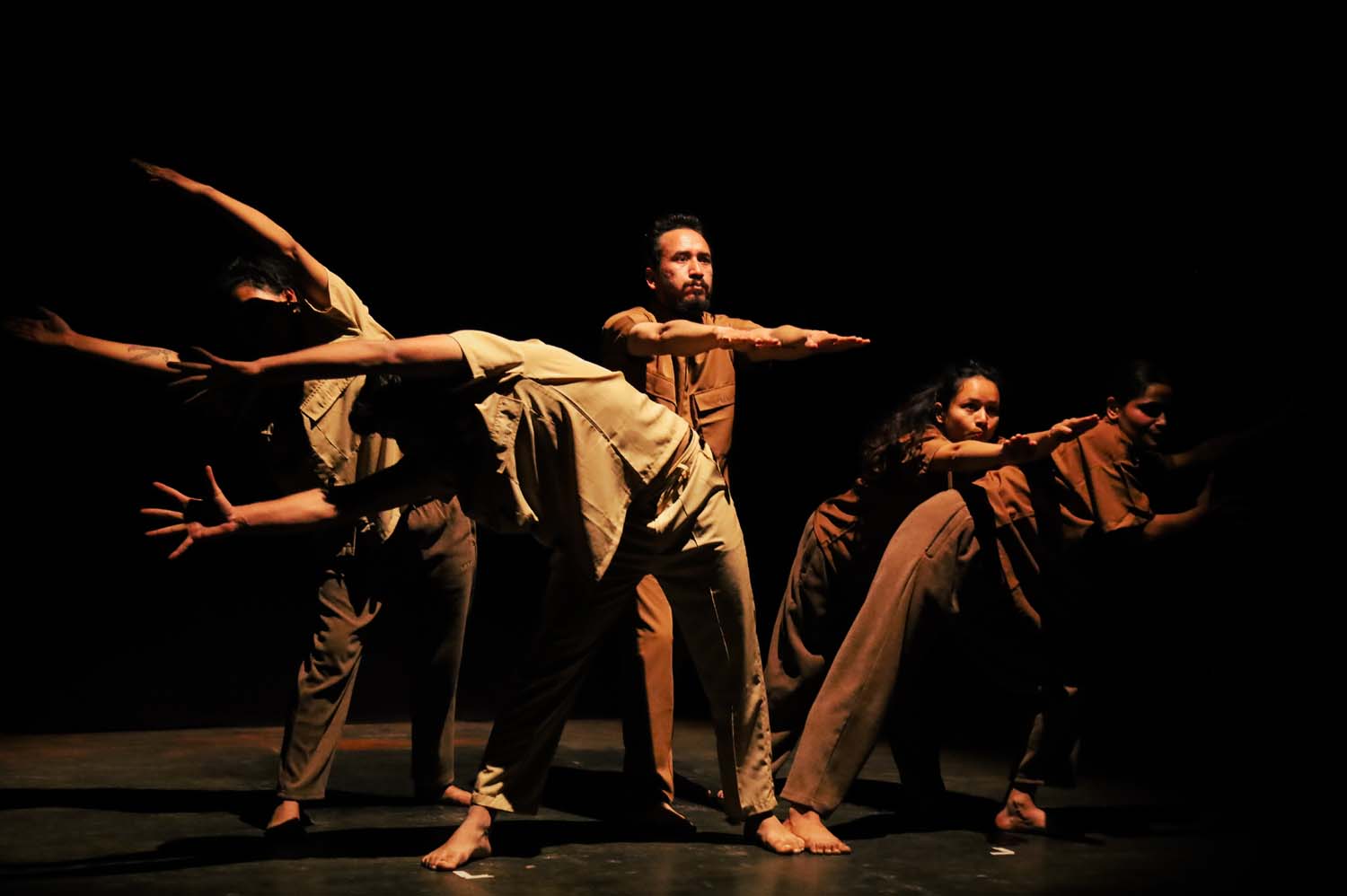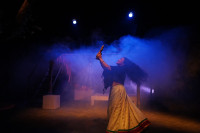Theater
A mimicry on existentialism
Sudam CK’s ‘Ubur Ubur Tikki’ is a dialogue-free exploration of human boundaries, emotions and the search for meaning through body movement and music.
Aarati Ray
No elaborate sets, no dialogues, no named characters—just body movement and music. That’s the signature style of director Sudam CK. Following ‘Aiya! Maya’ and ‘Paanch’, CK returns with yet another movement and sound-based theatrical play which uses the body to tell a story, or rather, many stories this time around.
Unlike the usual plays driven by dialogues, in ‘Ubur Ubur Tikki’, there is no fixed storyline. The audience can interpret the play as they see fit.
The play ‘Ubur Ubur Tikki’, currently staged at Kausi Theatre in Teku, Kathmandu, stars Akash Nepali, Binita Gurung, Sarita Kathayat, Nistha Tripathi, and CK. However, attempting to decipher the meaning behind every movement will lead to confusion.
What you need to do is just let your emotions and intuition take over logic and reasoning. I understood this 10 minutes into the play. As I was fretting over every little detail, I realised that not everything needs a crystal clear explanation. Rather, I should simply enjoy the experience. And that, I believe, is the point of this play.
We are often so lost in finding meaning and understanding everything about life, and where our paths and actions are headed, that we forget to live in the moment. The play encourages us to feel and live within the moments and be more conscious of our body movement. In doing so, we might comprehend less but feel more. Sometimes things become much clearer when we stop searching for meaning.
The bell rings and play begins. We see five actors, seemingly portraying insects chasing something akin to a ray of light. Sometimes, they run after their shadows, other times after each other. Sometimes support each other and other times, they fight one another. Throughout the play, I struggled to discern whether they were enemies, friends, different insects altogether, or different body parts of the same insect.
One thing that seemed constant, though, was that they were running after something, trying to find something, perhaps to find themselves in the dark.
The motifs, shadows, and the premise of characters running after light remind the audience of Plato’s ‘Allegory of the Cave’. In it, prisoners chained in a cave perceive shadows on a wall as reality because they have never seen the outside world. Similarly, in ‘Ubur Ubur Tikki’, the characters represent individuals trapped by their own perceptions or social constructs.
From what I have understood from Plato’s allegory, the play might also be challenging the audience to differentiate between illusion and reality in their own lives. Especially, the absence of dialogue and reliance on physical expression blur the lines between what is real and what is perceived, prompting viewers to question their understanding of reality.
While both the ‘Allegory of the Cave’ and ‘Ubur Ubur Tikki’ explore philosophical concepts of perception, reality and liberation, they do so through different mediums and narratives. Plato’s allegory is a philosophical thought experiment, while the play presents these ideas through song and body movements.
The play also invites the audience to explore existential themes of identity, question, and purpose. This can be linked to Shakespeare’s famous lines from ‘Hamlet’, “To be or not to be, that is the question’’, where he contemplates the nature of existence, wondering whether it is nobler to endure the hardships of life or to end one’s suffering through death.
Aside from the excellent delivery of intriguing themes, the play excels in its musical composition. Music director Naresh Gajurel’s background score keeps the audience engaged till the end. If the music wasn’t as good, the play might not have worked. Even the audience not habituated to watching plays void of dialogues might be drawn to the play, thanks to its score. Moreover, the coordination of actors’ body movements and expressions with music is very smooth.

Throughout the play, a whiteboard is used as an empty prop. In many scenes, we see insects looking at the whiteboard, getting shocked, bored or amazed. The whiteboard can be interpreted either as a mirror that shows the reality of one’s life or as an empty canvas that is waiting to be filled by colours inside every individual.
A noteworthy aspect of the play is the effective use of lighting. The skilled handling of light behind the scenes brings the production’s minimalistic aesthetic to life.
In an interview after the premiere, CK shared his interpretation of the play, saying, “We are conditioned to include and exclude, to see and not see, to hear and not hear, to accept and not accept, to follow and not follow, to praise and to loathe. We want to be different, and yet, we also want to be like others. The play is about the experiences of such human boundaries and to acknowledge, or perhaps celebrate, frailties and contractions.”
As CK suggests, ‘Ubur Ubur Tikki’ does focus on emotions, human experiences, and intuition over logic, which can be connected to various art and literary movements, like Romanticism, that prioritise emotional expression and intuitive understanding over strict rationality.
The play’s emphasis on silent communication through physical expression and music and its exploration of inner struggles and existential themes resonates with the Romantic notion of the ‘sublime’—the idea that emotional experiences can transcend rational understanding.
Moreover, the play’s focus on the human condition and the complexities of relationships echoes Romantic literature’s exploration of the individual’s connection to nature and society, as well as the tension between the rational and the emotional.
Through these connections, it is evident that CK’s play is an exemplary expression of art. But it also cannot be ignored that this form of play is an avant-garde experiment in the Nepali theatre scene.
For someone who is not familiar with plays driven by bodily movements and no dialogue, ‘Ubur Ubur Tikki’ might be confusing and possibly boring.
If you are enthusiastic about art and theatre, ‘Ubur Ubur Tikki’ is a must-watch. The play is a step towards revolutionising Nepali theatre with its silent yet strong narrative. It also promotes the notion that there are other forms of expression and communication besides vocal speech and words.
Ubur Ubur Tikki
Where: Kausi Theatre, Teku, Kathmandu
Director: Sudam CK
Music director/composer: Naresh Gajurel
Cast: Akash Nepali, Binita Gurung, Sarita Kathayat, Sudam CK
Duration: 1 hour
Date: Till March 31
Showtime: 5:00 pm (except Tuesday), extra 1:00 pm show on Saturday




 5.4°C Kathmandu
5.4°C Kathmandu








%20(1).jpg&w=300&height=200)

